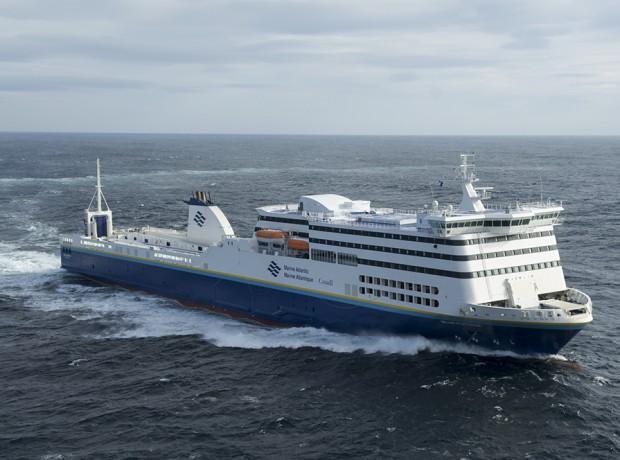Fleet Renewal – Working to Get the Right Vessels for our Service
Fleet renewal is a never ending discussion at Marine Atlantic. Changing customer needs and demand alone would prompt a continual review of what a future fleet might look like, and when you add in other variables such as improving and emerging technology, the evolution of ship design, the capacity requirements to meet the traffic demand over the life of a vessel, and the long lead time required to identify and charter new vessels (let alone design and build them!), we are constantly exploring options. And because customer needs, technology, and the other factors never stand still, the vessels we might consider at one time will likely not fit the bill at another.
As traffic patterns and customer requirements grew and shifted through the mid-2000s, we did not have the capacity to meet the demand. During this time a number of studies were conducted to determine what fleet configurations might meet our needs. In the Government of Canada’s budget of 2010, significant monies were made available for renewing the Marine Atlantic fleet. The capacity crunch our customers were facing dictated that a new build option would take too long, so a market search was undertaken to see what could meet our needs.
Stena, one of the world’s largest ferry operators and leaders in the design and construction of passenger and cargo vessels, presented an option, two Seabridger vessels that offered a significant increase in accessible deck space. But on two critical aspects – passenger comfort and technical performance in terms of maneuverability (specifically in Port aux Basques harbour) – we identified a number of essential changes that had to be addressed before we would consider these vessels for our service. In these discussions, we based our direction to Stena firmly on feedback and data.
Hospitality Newfoundland and Labrador commissioned a study in 2008 to explore desired passenger amenities for the future Marine Atlantic fleet. The report concluded that the lack of sleeping accommodations and schedule delays were consistently identified as major issues, as were long wait times, more and better quality seating, and improved food service options. While the Seabridger vessels offered almost 100 cabins, they were modified to carry up to 1,000 people in order to increase carrying capacity, and additional food service and seating areas were also added.
To address the maneuverability question, we relied on a report from Oceanic Consulting Corporation of St. John’s. In 2005, Oceanic had been commissioned to conduct a detailed study of the maneuverability of a 200m vessel, focused on docking and undocking in Port aux Basques.
As shown in the conclusion of their report below, Oceanic determined that a 200 meter vessel with high lift Becker rudders would have sufficient capability to successfully navigate the harbour, and be as effective as the MV Caribou in east-northeast winds at the 40 knot mark, “the most challenging with respect to completing the docking maneuver successfully.” (The ‘N2 hull’ referred to in the report is a notional design: a 200 meter ship with 2,980 kilowatts of bow thruster power.)
Oceanic did note that the use of podded propulsion would provide more flexibility than that of the Becker rudder option, as the pod units would allow docking “without the aid of bow thrusters”. Podded propulsion is far from standard in the ferry industry, and is most often seen on much larger vessels, such as cruise ships, where it is difficult to get sufficient bow thruster power for maneuvering. It is also very expensive to install and maintain.
Oceanic also suggested a stern thruster be added in the Becker rudder configuration to “provide increased flexibility” when docking in ice conditions, if, as they noted earlier in the report, “MAI’s operational experience has shown that rudder damage is a possibility when backing into ice”, a risk assessed as very low.
In working with Stena to modify the vessels to ensure maneuverability in the harbour, we relied on the information contained in the report. The MV Blue Puttees and MV Highlanders were shortened to their original design length of 199.5 meters, coming in at slightly less than the tested 200m length, and were outfitted with Becker rudders. In addition, we directed Stena to add more bow thruster power: a third thruster was installed to bring the total capacity to 4,700kw, a significant increase of almost 60% more capacity than the N2 design.
With these changes, the vessels met or exceeded the recommendations we received from the tourism industry and the expert consultants we had engaged. But of course, the only way to effectively evaluate the theoretical is in practice. And as shown in our blog post of February 19, our current fleet, led by the MV Blue Puttees and MV Highlanders, is performing extremely well.
The process Marine Atlantic follows when considering vessel changes starts with the theoretical, moves to a testing and modelling phase, and then to implementation. A range of data, studies, and expert opinion are taken into account throughout, along with ever-shifting external factors such as customer preferences, traffic composition, demand levels, and travel patterns and preferences.
Discussions on fleet renewal are ongoing, and will continue into the future. There will be different ships in the fleet over time, and every iteration will go through the same rigorous process of due diligence. We all recognize there is no perfect fleet; there will always be pros and cons to every vessel, whether it is a new build or a charter, and to every fleet configuration. Given we operate in one of the harshest marine environments in the world, even worse than the North Sea, there will always be weather delays. But no vessel decision is made lightly, and every vessel decision is made to provide the best possible service to our customers.


